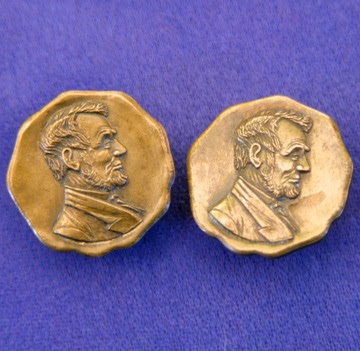It’s a great day for Americans to celebrate Independence Day, formally
established in the Declaration of Independence July 4, 1776!
Fourth of July Centennial Celebration:
Today I’d like to share an historical antique button, created from
tortoise shell, with inlaid silver, dated 1876, featuring the Art Gallery in
Philadelphia where the people celebrated the centennial of the signing of the
Declaration of Independence in 1776. At
this huge international fair, there were over 30,000 business exhibits, and
this lapel stud was a souvenir button.
Tortoise shell comes from the scaly shell of the hawksbill sea tortoise. It is chiefly composed of the protein keratin
(like horn). Inlays of silver, pearl, or
other materials were often pressed into the surface while the tortoise shell
was heated to a semi “plastic” state.
Tortoise shell polishes to a soft, rich sheen. The backs of some tortoise buttons show
scrape marks where the scales were cleaned.
When tested with a hot needle, it produces an acrid, fishy, or
seaweed-like smell. The finest work in
these materials was done a century or more ago. [All importation and commerce in elephant ivory, whale ivory, and
tortoise shell is now banned in the United States in an effort to protect these
animals from the ruthless exploitation which has nearly exterminated them.] (Ref.:
The Big Book of Buttons by
Hughes and Lester, Volume 1, Copyright 2010.)
To complement this beautiful button, I’m also featuring a treasured child’s
dress and apron, made in 1876. I hope
you enjoy the pictures of this dress and apron, including a photo of the hand
written note documenting its origin. The
note says, “My baby shirt and apron my grandmother Mary Dickerson gave in 1876
Centenial Year. Stella Gotto.” The peach
colored cotton dress has long sleeves, buttons in the back, gathers both above
and below the waist, and has lovely lined ruffles at the bottom of the skirt. The bib apron pins onto the bodice, ties at
the waist in the back, and has a lovely printed black filigree border and tiny
peach colored diamond shapes.
 |
| This is the hand written note that came through 136 years since the dress and apron were made. |
Notice below in this plate of children's fashions in 1876 from the University of Washington Libraries.
 |
| There are also ruffles at the bottom of the girls' dresses, just as in my 1876 dress above. |
 |
| This is another example of a child's dress fashionable in 1876. It also has gathers above and below the waistband, and ruffles at the bottom of the skirt, just like mine with the apron. |
The
Declaration of Independence is the founding document of American history. It is a statement adopted by the Continental
Congress on July 4, 1776, which announced that the thirteen American colonies,
then at war with Great Britain, regarded themselves as independent states, and
no longer a part of the British Empire.
This followed more than a year of fighting the Revolutionary War. So Independence Day of the United States of
America is celebrated on July 4, the day Congress approved the wording of the
Declaration.
Follow this link to read the actual document and reflect upon what our
forefathers considered to be human rights they were willing to fight for.
The introduction opens by stating the purpose of
the document--to declare the causes that compel the colonists to separate
themselves from the British Crown. The
second paragraph contains the philosophy upon which the declaration is based,
stating that "all Men are created equal, that they are endowed by their
Creator with certain unalienable Rights, that among these are life, liberty,
and the pursuit of happiness," that men institute governments in order to
secure these rights, and that when government attempts to remove these rights,
the governed have the right to rebel.
Governments are created to secure certain
unalienable rights, rights that are granted, not by government or man, but by
God. This is called an appeal to Natural Law. It is apparent the founding
fathers felt that God should play an important part in the government of man;
they do not, however, go into detail on the nature of that God. This, as
repeated nearly a decade later in the Bill of Rights, is up to the individual
and a right which, also, cannot be taken away by government.
Abraham Lincoln argued that the Declaration of
Independence is a statement of principles through which the United States
Constitution should be interpreted.
 |
| Writing of the Declaration of Independence |
Feel free to make comments, corrections, and additions. Email me at diannemarie8@gmail.com if you would like to communicate off the blog. I'm already working on my next blog article, and the plan is to write about various types of lace and give examples. Lace is one of the elements of many of my beautiful vintage and antique aprons; and I'm creating display boards with actual samples, names of the laces, and brief descriptions, so I can learn and also pass along the joy to others at my apron presentations. Soon I plan to write about patch pockets and other subjects related to aprons and buttons. Also check out www.pinterest.com/diannemarie8/ for more fun.


























